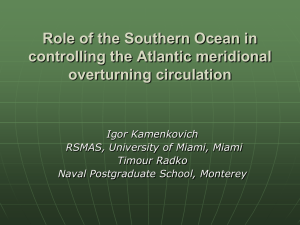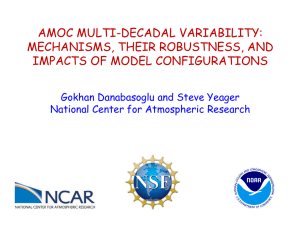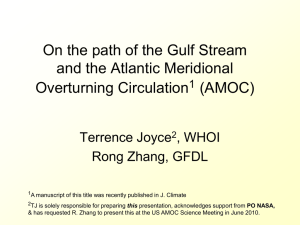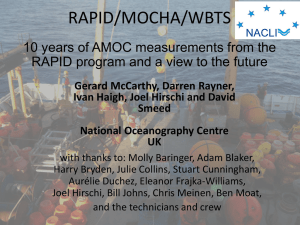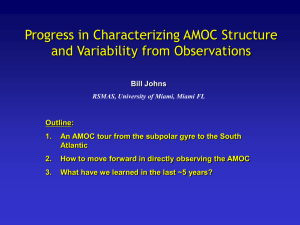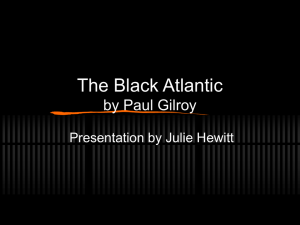Atlantic Multidecadal Variability - Lamont
advertisement
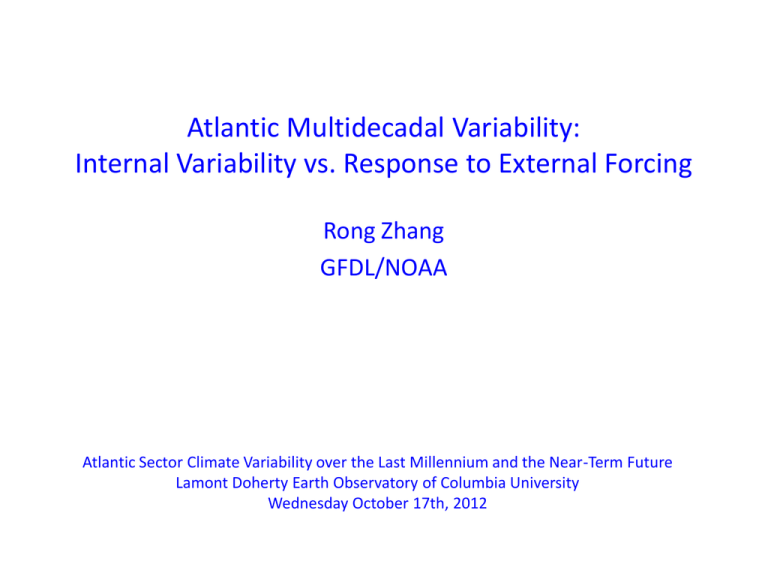
Atlantic Multidecadal Variability: Internal Variability vs. Response to External Forcing Rong Zhang GFDL/NOAA Atlantic Sector Climate Variability over the Last Millennium and the Near-Term Future Lamont Doherty Earth Observatory of Columbia University Wednesday October 17th, 2012 Atlantic Multidecadal Variability (AMV) Proxy based reconstructions of SST of past 330 years show a 70-year mode, and its spatial pattern resembles modeled multidecadal variability induced by AMOC variability (Delworth and Mann 2000). The North Atlantic basin averaged SST anomaly can be used as an AMOC fingerprint to reconstruct AMOC changes (Latif et al. 2004). Reconstructed multidecadal SST anomaly Observed multidecadal SST changes (Kushnir 1994) Model multidecadal SST anomaly !! " " # Delworth and Mann 2000 Simulated AMOC and SST anomalies (Latif et al. 2004) Atlantic Meridional Overturning Circulation (AMOC) The RAPID program was established since 2004 to monitor AMOC variations at 26.5oN [Cunningham et al. 2007], and provides important information about seasonal and inter-annual AMOC variations. However, much less is known for the low frequency AMOC variations. Greenland ice core record SST from subtropical northeast Atlantic AMOC change Paleo records from sediment cores in the North Atlantic suggest that the AMOC changes since LGM were coherent with the subtropical North Atlantic SST changes (McManus et al., Nature, 2004) Global Synchronization of Abrupt Climate Change Indicated by Paleo Records is Consistent with Modeled Responses to the Weakening of AMOC Schematic diagram of paleo records Modeled SST change due to the weakening of AMOC Modeled Precipitation Change due to the weakening of AMOC Paleo records and modeling results (Zhang and Delworth, 2005) suggest that: Weaker AMOC is linked to a southward ITCZ shift in both Atlantic and Pacific. This inter-hemispheric asymmetry is another signature of AMOC changes. The Linkage Between NASST and AMOC is Highly Debated • Some suggested that they are driven by changes in the radiative forcing (Mann and Emanuel, 2006; Booth et al. 2012). • Various approaches are proposed for quantitative attribution of NASST variations to a radiatively forced part and a part arising from AMOC variability (Kravtsov and Spannagle 2008; Ting et al. 2009; Zhang and Delworth 2009; Delsole et al. 2011; Wu et al. 2011; Ting et al. 2012). • Reconstruction AMOC variability using fingerprints are crucial for understanding the origin and the attribution of NASST variations. Forced and natural North Atlantic variability using signal-to-noise maximizing EOF analysis (Ting et al. 2009) Forced Response Natural Variability Forced and Natural North Atlantic Variability Response to External Forcing Internal Multidecadal Pattern (IMP) Delsole et al 2011 Forced and Natural North Atlantic Variability Decomposition using ensemble empirical mode decomposition (EEMD) (Wu et al. 2011) “Aerosols Implicated as a Prime Driver of Twentieth-Century North Atlantic Climate Variability” (Booth et al. 2012) The HadGEM2-ES climate model closely reproduces the observed multidecadal variations of area-averaged North Atlantic sea surface temperature (NASST) in the 20th century. The multidecadal variations simulated in HadGEM2-ES are primarily driven by aerosol indirect effects that modify net surface shortwave radiation (Booth et al. 2012). Key Discrepancies between HadGEM2-ES Simulations and Observations (Zhang et al. 2012) The HadGEM2-ES simulations show no trend in North Atlantic upper ocean heat content, in contrast to the substantial warming trend seen in observations. The discrepancy is mainly due to anthropogenic aerosols and suggests that aerosol effects are strongly overestimated in HadGEM2-ES. Key Discrepancies between HadGEM2-ES Simulations and Observations (Zhang et al. 2012) HadGEM2-ES (All Forcings) OBS SST Difference Between Cold (1961-1980) and Warm (1941-1960) Periods HadGEM2-ES (All Forcings)-(Constant Aerosols) net aerosol response The observed pattern is suggestive of an important role for AMOC variations, and related variations in Atlantic heat transport. The net aerosol response in HadGEM2-ES shows excess cooling in most ocean basins, and can not explain the observed pattern. Key Discrepancies between HadGEM2-ES Simulations and Observations The simulated subpolar NA SSS in HadGEM2-ES shows an unrealistic positive trend, mainly due to the aerosol response. The discrepancies in subpolar NA SSS suggest aerosol effects are strongly overestimated in HadGEM2-ES. Thompson et al. Nature, 2010: “Its amplitude is largest over the northern North Atlantic. The timing of the drop corresponds closely to a rapid freshening of the northern North Atlantic in the late 1960s/early 1970s (the ‘great salinity anomaly’) ” Great Salinity Anomaly (GSA) Events (Zhang and Vallis, 2006) Atlantic Meridional Overturning Circulation (AMOC) Fingerprints • To reconstruct the past AMOC variations when no direct observations are available, as well as to evaluate future AMOC impacts, it will be very useful to develop fingerprints for AMOC variations. • The fingerprints need to be variables that can be derived from both climate models and observations. The fingerprints would link the AMOC with variables that are observed extensively. • Identification of such fingerprints will contribute to the monitoring of AMOC variations, and improve assessments of the impacts of AMOC variability on global climate change. Tropical Fingerprint of AMOC variations Observed Tropical North Atlantic (TNA) SST is anticorrelated with TNA subsurface ocean temperature. The anticorrelation is a fingerprint of AMOC variations in GFDL coupled model simulations, indicating observed TNA SST fluctuations may be AMOC-related (Zhang 2007). Warming Cooling MODEL Cooling Surface MODEL Warming Subsurface (z=400m) Ocean temperature anomaly due to the weakening of AMOC from GFDL CM2.1 water hosing experiment The weakening of the AMOC leads to a southward shift of the Atlantic ITCZ, TNA surface cooling, and thermocline deepening and subsurface warming in the TNA Simulations driven by external radiative forcing changes do not generate anticorrelated surface and subsurface TNA variations. The observed anticorrelation between TNA surface and subsurface temperature indicates AMOC variations (Zhang 2007). Anticorrelated TNA Surface and Subsurface Temperature Late Early YD YD High-resolution temperature records of the last deglacial transition from a southern Caribbean sediment core show that warmer subsurface temperatures correspond to colder surface temperature and weaker AMOC during the Younger Dryas (Schmidt et al. 2012, PNAS, In Press) Extra-Tropical Fingerprint of AMOC variations Observed SSH PC1 and subsurface temperature (Tsub) PC1 Observed SSH PC1 r(SSH,Tsub) = 0.98 Modeled SSH PC1, Tsub PC1, AMOC Index from GFDL CM2.1 r(SSH,Tsub) = 0.85 The leading modes of SSH and subsurface temperature (Tsub) constitute a fingerprint of AMOC variations, and might be used as a AMOC proxy. It indicates that during the 60’s and the recent decade, the AMOC was stronger, and the recent slowdown of the subpolar gyre is a multidecadal variation (Zhang 2008). Regressions of Tsub anomalies on the AMOC Index show similar dipole patterns, i.e. warmer Tsub in the subpolar gyre and colder Tsub near the Gulf Stream path when AMOC is stronger. The stronger AMOC is associated with a stronger DWBC, which leads to the strengthening of the cyclonic NRG and a southward shift of the Gulf Stream path, thus leads to cooling/decreased SSH. The enhanced AMOC lags stronger deep convection in the Labrador Sea or in the Nordic Sea by several years. When denser deep current propagates into south and east of Greenland a few years later, it increases the vertical stratification thus reduces mixed layer depth in the subpolar gyre, resulted in a weakening of the subpolar gyre and thus warming/increased SSH. Indirect verification using AMO Modeled AMO Index has significant correlations with modeled AMOC Index, Tsub PC1, SSH PC1. Observed AMO Index has significant correlations with observed Tsub PC1for 1955–2003 The AMOC variations inferred from the observed Tsub PC1 are consistent with those inferred from the observed AMO index (Zhang 2008). Nordic Sea Overflow and Subpolar Gyre The high resolution global coupled model (GFDL CM2.5) shows that a stronger/weaker Nordic Sea overflow leads to a contracted/expanded subpolar gyre (Zhang et al 2011), consistent with the relationship indicated by sediment core records of the last millennium from Iceland Basin (Moffa Sanchez et al 2011) . Weaker Overflow and expanded subpolar gyre (SPG) Stronger Overflow and contracted subpolar gyre (SPG) Nordic Sea Overflow and Subpolar Gyre Proxy reconstruction of the last millennium from sediment cores in the Iceland Basin suggest a covariance between SPG and Nordic Sea overflow: expanded SPG‐slow overflow; contracted SPG – fast overflow (Moffa Sanchez et al 2011) AMOC (Perturbed –Control) The high resolution global coupled model (GFDL CM2.5) shows that a stronger and deeper-penetrating Nordic Sea overflow leads to a stronger and deeper AMOC, a westward shift of the North Atlantic Current (NAC), and a southward shift of the Gulf Stream, and a similar dipole pattern in the subsurface temperature as that found in the coarse resolution model. Summary • The AMV has been shown to be a good indicator of AMOC variations using both paleo records and climate models. However, the origin of the 20th century multidecadal NASST variations is highly debated, due to the complication of anthropogenic forcings. • Historical simulations in models with aerosol indirect effects (such as HadGEM2-ES) reproduce well the observed AMV. However, key aspects of the simulation show substantial discrepancies with observations, such as the NA upper ocean heat content, SST changes within and outside the NA, and in the subpolar NA SSS. These discrepancies are strongly influenced by aerosols, and thus call into question the realism of this model’s simulation of the aerosol influence on AMV. • Independent AMOC fingerprints have been identified, using variables such as altimetry SSH, subsurface temperature, and bring new evidence that the observed AMV are indeed linked to AMOC variations. Observed fingerprints of AMOC variability show that the AMOC was stronger during the 60’s and the recent decade, and weaker during the 70’s and 80’s. • The high resolution global coupled model (GFDL CM2.5) shows that a similar AMOC fingerprint in subsurface as that found in the coarse resolution model.
